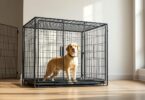Welcome to your comprehensive guide to caring for the Mini Aussiedoodle, a crossbreed that combines the intelligence of the Australian Shepherd with the charm of the Poodle. Whether you’re a new pet owner or an experienced one, understanding the unique needs of this hybrid breed is essential for providing the best possible care.
Mini Aussiedoodles have gained popularity due to their adaptable nature and hybrid vigor. They thrive in various living situations, from apartments to houses, making them a versatile choice for many families. Their friendly and affectionate temperament makes them ideal companions for singles, couples, and families alike.
In this guide, we’ll cover everything you need to know about grooming, health, exercise, training, and nutrition. Proper care is crucial to ensure your Mini Aussiedoodle leads a happy and healthy life. With the right approach, you can create a fulfilling environment for your pet.
Key takeaways from this guide include:
- Understanding the breed’s background and unique needs.
- Implementing effective care routines for grooming and health.
- Providing adequate exercise and training tailored to their energy levels.
- Ensuring a balanced diet that meets their nutritional requirements.
By following this guide, you’ll be well-equipped to raise a happy and healthy Mini Aussiedoodle, ensuring they receive the care they deserve.
Introducing the mini aussiedoodle: Overview & Key Characteristics
The Mini Aussiedoodle is a captivating crossbreed that brings together the Australian Shepherd’s intelligence and the Poodle’s charm. This designer dog has quickly become a favorite among families and individuals seeking a loyal, adaptable companion.
Breed Traits and Personality
Mini Aussiedoodles inherit the best traits from their parent breeds. They are known for their high intelligence, which makes them highly trainable. Their energy levels are moderate to high, making them a great match for active families. The breed is also known for its friendly and affectionate nature, making them excellent family pets.
Their coat is one of their most distinctive features. Mini Aussiedoodles often have a low-shedding, hypoallergenic coat, which is a result of the Poodle’s influence. This makes them a great choice for those with allergies. However, their coat does require regular grooming to prevent matting and tangling.
Why Choose This Designer Dog?
Mini Aussiedoodles are an ideal choice for families seeking a low-shedding companion. Their intelligence and energy make them highly trainable, which is why they excel in obedience and agility training. Aussiedoodle puppies are also known for their playful nature, making them a delightful addition to any household.
The hypoallergenic coat of the Mini Aussiedoodle is a significant advantage for many pet owners. While grooming is essential, the benefits of a low-shedding coat make it well worth the effort. With proper care and attention, Mini Aussiedoodles can thrive in various living situations, from apartments to homes with yards.
Caring for Your Mini Aussiedoodle: Grooming Essentials
Grooming is a vital part of caring for your Mini Aussiedoodle. Their long, low-shedding coat requires regular attention to stay healthy and look its best. A consistent grooming routine helps prevent matting, reduces shedding, and keeps your pet comfortable.
Brushing, Bathing, and Haircuts
Start with brushing 2-3 times a week to avoid tangles. Use a slicker or pin brush to gently work through their fur. Bathing should happen every 4-6 weeks using a dog-specific shampoo. Regular haircuts every 6-8 weeks by a professional groomer will keep their coat neat and manageable.
Ear, Nail, and Dental Health
Don’t forget other grooming tasks. Clean their ears weekly to prevent infections. Trim their nails every 3-4 weeks to avoid overgrowth. Dental care is also important—brush their teeth 2-3 times a week to maintain oral hygiene.
For more detailed grooming tips, visit our comprehensive guide to learn how to keep your Mini Aussiedoodle looking and feeling their best.
Maintaining Health and Wellness
Ensuring your Mini Aussiedoodle’s health and wellness requires a proactive approach. Regular veterinary check-ups are essential to catch any potential issues early and prevent them from becoming serious problems. Vaccinations are a critical part of this process, protecting your dog from dangerous diseases and maintaining their overall well-being.
Regular Vet Check-ups and Vaccinations
Veterinary care is the cornerstone of your Mini Aussiedoodle’s health. Routine check-ups help monitor their growth and detect any early signs of illness. Vaccinations are vital for preventing infectious diseases, ensuring your pet stays healthy and protected. Additionally, preventative care measures, such as flea and tick treatments, are important for maintaining their overall health and comfort.
Monitoring Genetic and Hybrid Health Concerns
While Mini Aussiedoodles benefit from hybrid vigor, they can still inherit certain health issues from their parent breeds. Eye and ear problems are common concerns due to their Poodle lineage. Regular monitoring and check-ups can help identify these issues early, allowing for prompt treatment and management. The size of your Mini Aussiedoodle, influenced by the Poodle’s genetics, also plays a role in their health management. Proper care ensures they lead a long, healthy life.
Mini Aussiedoodle Exercise & Activity Requirements
Keeping your Mini Aussiedoodle active is essential for their physical and mental well-being. This dog breed has high energy levels, requiring a mix of daily walks, playtime, and interactive activities to stay happy and healthy.
Daily Walks and Playtime
Aim for at least 30–45 minutes of exercise each day. Structured walks and play sessions help burn energy and keep your pup mentally stimulated. Interactive games like fetch or tug-of-war are great for bonding and exercise.
Engaging in Dog Sports and Interactive Games
Mini Aussiedoodles excel in dog sports such as agility and obedience training. These activities not only boost physical fitness but also challenge their minds. Regular exercise helps manage energy levels and prevents boredom, ensuring your dog stays balanced and content.
Remember, activities should suit your dog’s age and size. Consistency is key to maintaining their health and happiness.
Training and Socializing Your Mini Aussiedoodle
Training and socializing your Mini Aussiedoodle are crucial for their development. These efforts help build confidence and ensure they interact well with others.
Positive Reinforcement Techniques
Positive reinforcement is key to effective training. Use treats and praise to encourage good behavior, making learning enjoyable. This method helps teach tricks and obedience, providing mental stimulation and strengthening your bond.
Early Socialization for Confidence
Socialization is vital during the first few months. Expose your puppy to new environments, people, and other animals to build confidence. Activities like puppy classes and playdates can enhance their social skills and reduce anxiety.
A well-trained and well-socialized dog leads to a more enjoyable life. They form stronger family bonds and adapt better to various situations. Consistent training and positive reinforcement ensure your Mini Aussiedoodle grows into a happy, well-adjusted companion.
Understanding the Breed’s History and Parent Breeds
The Mini Aussiedoodle’s story begins with the fusion of two distinct breeds, each bringing unique qualities to the table. This crossbreed combines the Miniature Australian Shepherd and the Poodle, creating a dog known for its intelligence and charm.
The Role of the Miniature Australian Shepherd
The Miniature Australian Shepherd, developed in the U.S. since the 1960s, contributes a strong herding instinct and a lively, energetic nature. Bred to manage smaller livestock, this breed is intelligent and adaptable, traits that shine in the Mini Aussiedoodle.
The Influence of the Poodle Heritage
The Poodle, with its origins tracing back to 15th-century Germany, adds elegance and intelligence. Its hypoallergenic coat is a significant feature, making the Mini Aussiedoodle a great choice for those with allergies.
The blend of these breeds results in a dog with a unique personality—intelligent, active, and affectionate. Historically, the popularity of Mini Aussiedoodles has grown since the 1990s, aligning with the rise of designer breeds.
This mix not only offers a low-shedding coat but also a versatile nature, making the Mini Aussiedoodle suitable for various lifestyles and activities. Their evolution over time reflects the demand for intelligent, adaptable companions.
Exploring Mini Aussiedoodle Sizes and Generational Differences
Understanding the different generations and sizes of Mini Aussiedoodles is key to making an informed decision. Each generation and size offers unique characteristics that can suit various lifestyles and needs.
F1, F1b, and F2 Generations Explained
F1 Mini Aussiedoodles are a 50% Australian Shepherd and 50% Poodle mix, offering moderate shedding and high energy. F1b Mini Aussiedoodles, with 75% Poodle and 25% Australian Shepherd, are lower-shedding and calmer, ideal for those with allergies. F2 Mini Aussiedoodles, a mix of two F1s, vary in traits but often require more grooming.
Size Variations: Toy, Teacup, and Standard
Toy Mini Aussiedoodles weigh 15-30 pounds, while Teacup versions are under 6 pounds. Standard Mini Aussiedoodles range from 30-40 pounds. Each size affects daily care, with larger dogs needing more exercise and smaller ones requiring gentler handling.
Behavior varies with size: Toys are playful yet adaptable, while Standards are energetic and social. For allergy sufferers, F1b generations are recommended due to their low-shedding coats. Learn more about size impacts in our size guide.
Nutritional Guidelines and Feeding Tips
Proper nutrition is the cornerstone of a healthy, happy Mini Aussiedoodle. Understanding their dietary needs at different life stages ensures they receive the right balance of nutrients for optimal growth and energy.
Puppy vs. Adult Feeding Requirements
Puppies and adult dogs have different nutritional needs. Puppies require more frequent, smaller meals to support rapid growth. Typically, 3-4 meals a day are recommended for puppies, while adults thrive on two meals daily. Portion sizes should be adjusted based on age, size, and overall health.
Diet Choices to Support Energy and Health
Selecting high-quality, AAFCO-approved dog food is essential. Look for formulas with real meat as the first ingredient, supplemented with omega fatty acids and essential vitamins. Addressing common feeding issues like overfeeding or underfeeding is crucial for maintaining a healthy weight and energy levels.
Consulting a veterinarian can help tailor feeding plans to your dog’s specific needs. For more detailed feeding tips and health advice, visit our complete guide to ensure your Mini Aussiedoodle leads a thriving life.
Practical Tips for Everyday Mini Aussiedoodle Care
Creating a consistent daily routine is key to ensuring your Mini Aussiedoodle stays happy and healthy. By combining grooming, feeding, exercise, and training into a structured schedule, you can provide the care they need to thrive.
Establishing a Consistent Routine
A well-organized daily routine helps your dog feel secure and develops good habits. Start by designating specific times for meals, play, grooming, and training. This structure not only supports their physical health but also their mental well-being.
- Feeding and Playtime: Begin the day with a short walk and play session, followed by breakfast. Midday play helps burn energy, and an evening walk before dinner keeps them active.
- Grooming Sessions: Morning and evening grooming sessions prevent matting and keep their coat healthy. Use a slicker brush to gently work through their fur, paying attention to areas prone to tangling.
- Training Time: Dedicate 10-15 minutes daily to training. Use treats as rewards to reinforce good behavior. Start with simple commands like “sit” or “stay” and gradually introduce more complex tasks.
Incorporate agility exercises into your routine. Set up a small obstacle course at home using tunnels or cones. This not only provides physical exercise but also mental stimulation. Remember to always supervise playtime to ensure safety.
A structured routine offers numerous benefits. It helps establish good behavior, reduces anxiety, and strengthens the bond between you and your dog. Consistency is key, so stick to your schedule as much as possible, even on weekends.
Bringing It All Together: Tips for a Thriving Mini Aussiedoodle
Caring for your Mini Aussiedoodle requires a holistic approach that combines grooming, exercise, nutrition, and socialization. This crossbreed thrives on consistency and attention to detail, ensuring they remain healthy and happy. Whether you’re focusing on their coat care or their dietary needs, every aspect plays a role in their overall well-being.
Understanding the breed’s crossbreed origins and color variations can guide better care decisions. For instance, their coat color may influence grooming needs, while their energy levels from the Australian Shepherd side will shape your exercise routine. This article has covered everything from daily routines to health checks, providing a roadmap for pet owners.
As you navigate life with your Mini Aussiedoodle, remember to revisit specific sections of this guide for tailored advice. Regular grooming sessions, balanced meals, and engaging activities are just a few pieces of the puzzle. For more insights on related breeds, explore our complete guide to ensure your pet leads a fulfilling life.










Leave a Comment